The Problem
In the spring of 2009, a group of adventuresome whitewater kayakers dipped their boats into the meager headwaters of the North Fork of the Virgin River above Zion National Park. The weather was cold, but spirits were high. The paddlers had read about kayaking through the Zion Narrows in the preeminent whitewater guidebook for the southern Rockies. Confident their paddling abilities were more than up to the task, the group shrugged off having to frequently drag their boats through early shallow stretches. They knew the North Fork of the Virgin River picked up most of its flow from a tributary a few miles downstream. Once they hit the tributary, they’d be paddling Class III whitewater in one of the most spectacular box canyons in the world.
But neither the guidebook nor this group of paddlers had accounted for a winter’s worth of log jams that had filled the canyon. And as the walls closed in, this group quickly realized the Class III whitewater held Class V danger.
Log jams in a river act as a strainer. And if you paddle or swim into one, you become the pasta caught in the strainer. Best avoided at all costs, if you can’t avoid a strainer you should fight like mad to get over the strainer—either by paddling over it or climbing over it.
That day in the canyon, the most experienced paddler in the group suffered the worst of the abuse. He cracked his kayak after hitting a submerged rock. Trying to reach an eddy, he missed his friend yelling out a warning to him. With little time left, he looked up to see a partly submerged log jam spanning the river ahead of him. He tried to paddle over top but got pulled under. Forced to swim out of his kayak in search of air, he struggled mightily to climb up and over the strainer. With the last of his strength, he swam away from the log jam to a small bank.
Now stranded without a kayak and with daylight fading, the man watched as his group paddled on without him. The group’s promise to send emergency help rang in his ears as they rounded the bend and were lost from sight.
He pulled on all the clothing he had—even his personal flotation device (PFD) —and ate the energy bars his group left for him, hoping a full stomach might help fight off the cold. It didn’t.
He spent the night trying to overcome uncontrollable shivering by doing endless sit ups. By morning, he was exhausted.
Still stranded, he watched and waited all day for help. But none came. He began to wonder whether he could survive the exposure of another night under the stars.
And then a memory from years earlier flashed across his mind. He recalled dropping a lighter into the pocket of his PFD. He desperately began searching his PFD, hoping against hope that his memory held true.
It did. He found the old lighter and carefully dried it out. Once dry, he cranked down on it. A yellow flame erupted. With the joy of salvation spreading across his face, he quickly gathered up driftwood and lit a raging bonfire.
A Solution—Fire Kits
More than 16 years later, I can vividly remember reading the trip report from the kayaker whose life was saved by a lighter. Like the nearly frozen paddler, I was a young(er) whitewater kayaker with dreams of adventure. And as someone who was raised to be prepared, I quickly realized how unprepared I would have been in the same situation.
So I started building emergency fire kits for my PFDs. Over time, I’ve tinkered with the contents of the kits, but the basic goal has always been the same: sustain life until help arrives.
Several years ago, I began giving out emergency fire kits as gifts. So when my wife and several women from our area started a weekly hiking group, I made each of them a deluxe fire kit—those kits had everything from a ferro rod to a LifeStraw water filter. The hikers were all very gracious, but one said to my wife, “where does he think we go hiking?” Not surprisingly, those hikers don’t carry my kits when they hike. The kits were too heavy and too bulky. Lesson learned.
So I paired the kits down to what I now call the “Goldilocks” kit. Not too much, not too little, just right.
Last week, I gave away my last two Goldilocks kits to a pair of young fathers who live near me. Each of those men commutes to work in a nearby large city. Each would have a one-to-two-day ruck to get back home to his family if he lost the ability to drive—like after a major earthquake. So I gave them each a kit and hoped it might spur them to prepare more.
Having run out of kits, this week I assembled new kits. And I thought I’d share the current version of my Goldilocks kit with you.
Lighter
A lighter forms the foundation of the kit. For these fire kits, I prefer Bic mini lighters. Certainly, better lighters exist. But for their price, weight, and intuitive use, Bic minis are hard to beat.
Matches

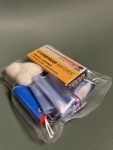 For combustion, two is one and one is none. So each kit contains a box of 25 waterproof and stormproof matches. If the kit takes on water and the lighter won’t work, the matches will still work. While I keep a ferro rod in my PFD fire kit, I’ve left it out of my Goldilocks kits. Most people haven’t practiced enough with a ferro rod to rely on it in an emergency. And keeping the kits’ size and weight down will hopefully result in more people carrying the kits.
For combustion, two is one and one is none. So each kit contains a box of 25 waterproof and stormproof matches. If the kit takes on water and the lighter won’t work, the matches will still work. While I keep a ferro rod in my PFD fire kit, I’ve left it out of my Goldilocks kits. Most people haven’t practiced enough with a ferro rod to rely on it in an emergency. And keeping the kits’ size and weight down will hopefully result in more people carrying the kits.
Fire Starter
Over the years, I’ve experimented with several fire starters. For example, in my youth we used fatwood—we called it fat lighter—with good results. As an adult leader of Boy Scouts, I once asked another adult leader if he thought we could help the boys make the ultimate fire starters. With a look that said, “Hold my root beer,” he started to gather up supplies: Cannon fuse, red phosphorus, black powder, paraffin wax, cotton rounds, and wood shavings all have their place in this world. But when combined, the results of the spark hitting that fire starter can be exciting—I doubt any of those scouts will forget it!
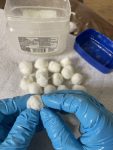
 For these Goldilocks kits, however, I use cotton balls rolled in petroleum jelly. They’re tried and true. They light easily and burn for several minutes apiece. Each Goldilocks kit contains four cotton balls. I cover up the cotton balls in plastic wrap to keep the kits’ other contents from getting greasy.
For these Goldilocks kits, however, I use cotton balls rolled in petroleum jelly. They’re tried and true. They light easily and burn for several minutes apiece. Each Goldilocks kit contains four cotton balls. I cover up the cotton balls in plastic wrap to keep the kits’ other contents from getting greasy.
Water Purification
While thermoregulation takes first priority in the kits, I also want these kits to enable someone to treat water. And because filters like LifeStraw and the Sawyer Mini are too big and too expensive for these Goldilocks kits—and because they may freeze in winter conditions—I’ve settled on chemical treatment. Over the years I’ve used several brands, but I prefer Aquatabs because they work after just 30 minutes.
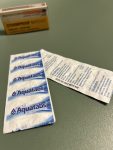
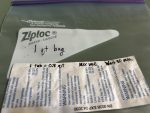 And, because they’re not wholly intuitive to use, I write some very brief directions on each strip of Aquatabs. Each strip contains ten tablets. I put one strip in each Goldilocks kit. Ten tablets yields 8 quarts of treated water. Finally, because not everyone will find themselves stranded with a water bottle, I include a quart-sized Ziplock bag. The bag can comfortably hold enough water for one tablet to purify.
And, because they’re not wholly intuitive to use, I write some very brief directions on each strip of Aquatabs. Each strip contains ten tablets. I put one strip in each Goldilocks kit. Ten tablets yields 8 quarts of treated water. Finally, because not everyone will find themselves stranded with a water bottle, I include a quart-sized Ziplock bag. The bag can comfortably hold enough water for one tablet to purify.
Overall
 With my components gathered, I place them in a plastic bag and seal up the top. I’ve stopped vacuum-sealing the bags—I just seal them with air inside the pouch. Doing so allows me to slide the bag’s contents around a bit after the bag is sealed. And having air in the bag makes them more comfortable to carry in a pocket. Air helps them float, too. In total, these Goldilocks kits weigh just over two ounces. They’re about four inches square, making it pretty convenient to drop one into a pocket, backpack, or a glove compartment.
With my components gathered, I place them in a plastic bag and seal up the top. I’ve stopped vacuum-sealing the bags—I just seal them with air inside the pouch. Doing so allows me to slide the bag’s contents around a bit after the bag is sealed. And having air in the bag makes them more comfortable to carry in a pocket. Air helps them float, too. In total, these Goldilocks kits weigh just over two ounces. They’re about four inches square, making it pretty convenient to drop one into a pocket, backpack, or a glove compartment.
Full Circle
While the Park Service now forbids kayakers from paddling the Zion Narrows, adventurous hikers can follow the 17-mile river trail through the Narrows once the water level drops to a manageable level for hiking.
Earlier this month, my son and I drew out a permit to hike the Zion Narrows from the top down. Because all the rivers and streams in Zion National Park now contain Cyanobacteria, I didn’t bring a filter for our hike. Instead, we planned to carry all our water with us—about five quarts each.
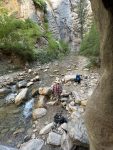
But when I picked up my hiking permit, the ranger who issued the permit told me that a natural spring at mile 12 on our hike was potable, so long as we treated or filtered the water. Excited at the prospect of carrying less water weight, I felt silly for leaving my water filters at home. But then I remembered the water treatment tablets in my fire kit. Problem solved. The next day, as we travelled down the Narrows, I noticed deadfall and strainers throughout the hike. I thought about the nearly frozen kayaker from years earlier, what it must have felt like being stranded, and how cold he must have felt soaking wet in the half-light of the canyon as darkness set in.
For the nearly frozen kayaker in 2009, his lighter likely saved his life—and the life of several others. Near the end of his second day in the canyon, four more kayakers rounded the bend and found the boatless kayaker sitting by his fire, contemplating his next move. The new group paddled a mix of hardshell and inflatable kayaks.
Like the stranded kayaker, this new group had struggled to navigate around the log jams and strainers. They had no hope of finishing the run before nightfall, but they wanted to push on another hour or so until dark. They invited the stranded kayaker to join them—they would simply double up in one of the inflatable kayaks. With gratitude, he agreed.

After a hard mile or two, the group of five camped for the night deep in the canyon. Using the first kayaker’s lighter, they built another fire and kept it burning low throughout the night, struggling to find enough dry wood to burn. With clear skies and bright stars visible in a slender ribbon above them, that night was the coldest of the entire ordeal. The next day, the benumbed group carefully worked its way down the canyon to the takeout at the Temple of Sinawava trailhead. Those five kayakers learned something on that trip that many of us have had to learn the hard way: the profound joy a little fire can spark. But once you’ve felt it, you want to share it. I give these Goldilocks fire kits away to family, friends, and colleagues with the hope that if they ever find themselves in need, they’ll have a way to survive until help arrives. I hope that by sharing this, you, too, might benefit.
Read the full article here

